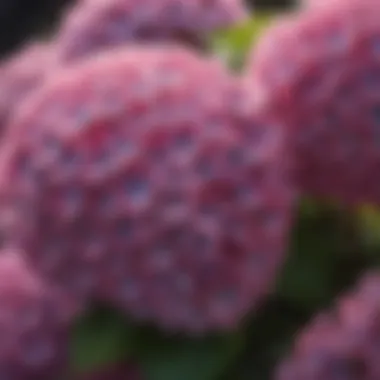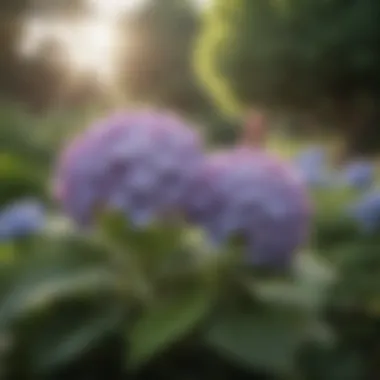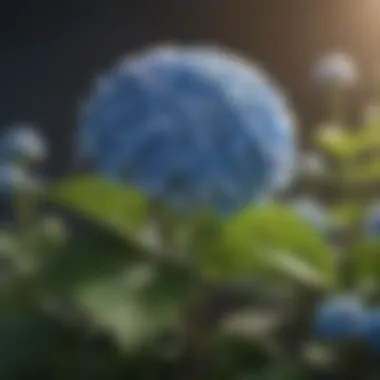Understanding Bloom Struck Hydrangea: A Complete Guide


Intro
The Bloom Struck Hydrangea is a captivating hybrid, distinguished by its ability to thrive in various conditions while producing striking blooms. As a gardener or plant enthusiast, understanding its needs and traits can lead to a more fulfilling gardening experience. This guide aims to unravel the essential aspects of Bloom Struck Hydrangea, offering insights into its classification, growth conditions, maintenance, and its impact on landscape design.
Fascinating Facts About the Bloom Struck Hydrangea
Unique Characteristics
The Bloom Struck Hydrangea stands out for its unique coloring. The flower heads can display a mix of pink and blue hues, depending on soil pH levels. This versatility gives it an edge in landscape applications, allowing gardeners to create visually captivating effects. The leaves are glossy, which adds to its ornamental appeal.
Extraordinary Abilities
What makes this plant exceptional is its resilience. Bloom Struck Hydrangea is known for being more tolerant to both drought and humidity compared to traditional hydrangeas. This adaptability allows it to thrive in diverse environmental conditions, making it a suitable choice for various regions.
Optimal Growing Conditions
To cultivate healthy Bloom Struck Hydrangeas, certain growing conditions should be met. These include:
- Soil Type: Well-draining soil rich in organic matter is ideal. A mixture of loam and mulch can enhance growth.
- Sunlight: Partial shade is preferred. Direct sunlight can scorch the blooms.
- Watering: Consistent moisture is vital. Regular watering during dry spells is important to keep the plant hydrated.
Maintenance Requirements
Maintaining Bloom Struck Hydrangeas is relatively straightforward. Regular pruning is necessary to promote new growth and enhance blooming. Here are some specific tips:
- Fertilization: Use a balanced fertilizer in spring to support healthy growth.
- Pest Control: Always monitor for pests such as aphids. Using appropriate insecticides when necessary can prevent infestations.
- Winter Care: In colder climates, protecting the root zone with mulch can prevent freeze damage.
Role in Horticulture
Bloom Struck Hydrangeas have gained importance in garden design. Their vibrant colors and hardy nature make them favorable for both residential and commercial landscapes. Gardeners often use them in borders, foundation plantings, or as stand-alone specimens.
The Bloom Struck Hydrangea is not just a plant but a statement in landscape design that brings both resilience and beauty to gardens.
End
Understanding the Bloom Struck Hydrangea entails acknowledging its distinct characteristics, optimal growing conditions, and maintenance practices. This hybrid plant, admired for its beauty and robustness, can significantly enhance any garden setting. By taking the time to provide the right care and environment, gardeners can enjoy the blooms of this remarkable hydrangea for years to come.
Preface to Bloom Struck Hydrangea
Understanding the Bloom Struck Hydrangea is crucial for anyone interested in horticulture, especially those who value unique and resilient plants. This section serves as a gateway into the extraordinary characteristics that set this hybrid apart. It is not just a plant; it symbolizes a fusion of beauty and adaptability, making it a desirable addition to a wide range of landscapes.
Overview of Hydrangea Varieties
Hydrangeas are a diverse family of flowering plants, broadly classified into several species, including Hydrangea macrophylla, Hydrangea paniculata, and Hydrangea arborescens. Within these species, there are numerous cultivars, each showcasing distinct flower shapes and colors. The Bloom Struck Hydrangea is a noteworthy hybrid belonging to the mophead variety. Its unique petals and robust growth patterns make it a favorite among gardeners.
The popularity of Bloom Struck lies in its adaptability. Unlike many hydrangeas that can be sensitive to temperature and soil conditions, this variety thrives in various settings. It can be found in home gardens, public parks, and botanical collections. The plant can exhibit both pink and blue blooms, depending on the pH of the soil in which it is planted.
Key features of various hydrangea varieties include:
- Hydrangea macrophylla: Known for its large, ball-shaped blooms.
- Hydrangea paniculata: Features cone-shaped flower clusters and is more tolerant of colder climates.
- Hydrangea arborescens: Commonly recognized for its flat-topped flower clusters.
- Bloom Struck Hydrangea: A hybrid boasting resilience and the ability to produce flowers from mid-summer to fall.
Significance of Bloom Struck Hydrangea
The Bloom Struck Hydrangea holds particular significance for several reasons. First, its ability to thrive in various environments makes it a practical choice for gardeners, whether they are experienced or just starting. The resilience of this plant means it can endure elements that other varieties might not manage, making it more accessible for families and community gardens.
Moreover, the blooms of the Bloom Struck have exceptional visual appeal. Ranging from soft pinks to striking blues, they create a colorful display that enhances any outdoor space. This versatility in color not only elevates a garden's aesthetic but also holds cultural value in many settings. Blooms can adapt in color with adjustments to soil chemistry, offering an interactive gardening experience.
In summary, the Bloom Struck Hydrangea’s unique attributes and ornamental value solidify its place in landscaping and gardening. By understanding its characteristics, one can fully appreciate its role in contributing to various horticultural practices.


Botanical Classification
Understanding the botanical classification of the Bloom Struck Hydrangea is crucial for many reasons. Firstly, it provides a framework for identifying and categorizing various hydrangea types, which is essential for both gardeners and horticulturists alike. The scientific classification sheds light on the relationships between different plant species, enhancing the comprehension of their genetic makeup, growth habits, and environmental preferences.
By delving into the taxonomy of Bloom Struck Hydrangea, readers gain insights into how this hybrid differs from other hydrangeas. This knowledge is important not only for cultivation but also for appreciating the plant's unique contributions to ecosystems and landscape designs.
Taxonomy of Bloom Struck Hydrangea
The Bloom Struck Hydrangea scientifically belongs to the genus Hydrangea and is a hybrid, primarily derived from Hydrangea macrophylla. Understanding its taxonomy involves recognizing its lineage and hybrid status. Hybrids like Bloom Struck often emerge from the crossing of two or more distinct parent plants, resulting in unique characteristics that are not present in either parent.
In this case, the Bloom Struck demonstrates features that may be inherited from its parents' traits, such as color variety and blooming patterns. The plant has notable resilience, which is a direct benefit of its hybrid nature.
Identifying its precise classification can help in understanding its growing conditions and care requirements. This information is valuable for gardeners aiming to successfully cultivate Bloom Struck in their landscapes.
Hybrid Characteristics
Bloom Struck Hydrangea showcases several key hybrid characteristics that distinguish it within the broader category of hydrangeas. One aspect is its ability to produce flowers in varying colors depending on soil pH. This feature allows gardeners to manipulate bloom colors from blues to pinks, adding versatility to their gardens.
Moreover, the hybrid nature contributes to its vigorous growth and hardiness. Bloom Struck is known for its resistance to common pests and diseases that often affect other hydrangeas, making it a practical choice for gardeners seeking low-maintenance options.
Additionally, the plant blooms continuously throughout the growing season, providing a long-lasting display of flowers. This consistent blooming period enhances its ornamental value in gardens and landscapes.
In summary, understanding the botanical classification of Bloom Struck Hydrangea enriches the appreciation of its distinctive qualities and cultivation strategies. The taxonomy and hybrid characteristics play vital roles in how this plant is enjoyed and utilized in horticulture.
Growing Conditions
Growing conditions are vital for the overall health and vibrant appearance of Bloom Struck Hydrangea. This hybrid plant thrives in specific environments that optimize growth, bloom quality, and resilience. Understanding these conditions will ensure the best results when cultivating this beautiful shrub.
Soil Requirements
The soil for Bloom Struck Hydrangea is crucial. This plant prefers well-drained, loamy soil with a slightly acidic to neutral pH, ideally between 5.5 and 7.0. Proper drainage is important to prevent root rot, which can be detrimental to health.
To improve soil quality, consider incorporating organic matter, such as compost or peat moss. This enriches the soil, providing the necessary nutrients while enhancing moisture retention. Amending compacted soil will allow roots to expand and access water and nutrients effectively.
Key Points on Soil Management:
- Drainage: Ensure the soil allows for proper drainage.
- Nutrient Content: Use organic materials to enrich the soil.
- pH Balance: Aim for a pH between 5.5 and 7.0.
Light Exposure
Light exposure plays a significant role in the blooming and growth of Bloom Struck Hydrangea. This plant thrives best with partial sunlight, ideally receiving around four to six hours of direct sunlight daily. Too much direct sunlight can scorch the leaves, while insufficient light can hinder blooming.
It is essential to assess the planting location carefully. An area that receives morning sunlight and afternoon shade often yields better results. Monitor the growth and adjust the position of the plant if necessary.
Important Considerations for Light:
- Moderation: Four to six hours of sunlight is optimal.
- Morning Sun: Helps improve bloom quality without excessive heat.
- Location Shifts: Adjust plant position if growth appears stunted.
Watering Needs
Watering is a critical aspect of maintaining a healthy Bloom Struck Hydrangea. This plant appreciates consistent moisture but does not tolerate soggy roots. A deep watering strategy is preferred, with the soil allowed to dry slightly between watering sessions.
During dry spells or summer months, the plant may require more frequent watering. However, it is crucial to monitor conditions to avoid overwatering, which can lead to root diseases and overall decline of the plant.
Guidelines for Water Management:
- Frequency: Water deeply but allow soil to dry slightly.
- Seasonal Adjustments: Increase watering during hot, dry periods.
- Monitoring: Check soil moisture levels regularly.
Proper growing conditions are essential for the success of Bloom Struck Hydrangea. Achieving the right balance in soil, light, and watering will maximize the plant's potential in any landscape.


Plant Care and Maintenance
Effective plant care and maintenance are vital for the growth and longevity of Bloom Struck Hydrangea. Understanding these elements can mean the difference between thriving, vibrant plants and lackluster displays. Proper care ensures that this hybrid remains lush and blooms beautifully throughout its growing cycle. This section will delve into pruning, fertilization, and pest management—key practices that support the overall health of the plants.
Pruning Techniques
Pruning Bloom Struck Hydrangea is essential for maintaining its structure and promoting healthy blooms. The best time to prune is in late winter or early spring before the new growth starts.
- Remove Dead or Damaged Wood: Regularly inspect the plant for any dead branches or damaged stems, cutting them back to promote airflow and reduce disease risk.
- Shape the Plant: Trim back the plant to control its size and maintain an attractive shape. This is especially effective after the blooming period, ensuring the next cycle will be full of new flowers.
- Encourage New Growth: Lightly prune to avoid removing too many buds. Focus on cutting just above a node to encourage new shoots which help enhance flower production.
By adopting these pruning techniques, gardeners ensure their Bloom Struck Hydrangea remains healthy and productive.
Fertilization Strategies
Fertilizing Bloom Struck Hydrangea appropriately supports its growth and blooming. Fertilization must be carefully timed and executed. Here are essential strategies:
- Balanced Fertilizers: Use a balanced fertilizer, such as a 10-10-10 NPK, in early spring after the last frost. This prepares the plant for the growing season.
- Slow-Release Options: Opt for slow-release fertilizers to ensure nutrients are available over an extended period, enhancing root development.
- Consider Soil pH: The pH of the soil affects nutrient availability. Ensure the soil is slightly acidic to neutral (pH 6.0 to 7.0) for optimal absorption.
Regular monitoring of soil health and strategic fertilization will help maintain the vigor of Bloom Struck Hydrangea.
Pest and Disease Management
Protecting Bloom Struck Hydrangea from pests and diseases is crucial for maintaining its health. Several preventive measures can be employed:
- Regular Inspections: Frequently examine the foliage and stems for signs of pests like aphids or spider mites. Early detection is key to managing outbreaks before they escalate.
- Cultural Practices: Practices such as maintaining good air circulation and proper watering can prevent diseases like powdery mildew.
- Organic Treatments: When pests are identified, consider applying organic insecticides or natural remedies like neem oil, ensuring they are safe for the plant.
By being proactive in pest and disease management, gardeners can enjoy healthy and beautiful Bloom Struck Hydrangea plants year after year.
It's essential to adapt your plant care techniques based on changing conditions and the specific environment of your garden.
Bloom Cycle and Seasonal Changes
Understanding the bloom cycle and seasonal changes of the Bloom Struck Hydrangea is essential for anyone interested in cultivating this unique plant. The blooming period and the color changes in its flowers not only contribute to its aesthetic appeal but also influence care techniques and landscape planning. A deeper awareness of these factors can enhance gardening success while maximizing the plant's visual impact in various settings.
Blooming Period
The blooming period of the Bloom Struck Hydrangea typically unfolds from late spring to early fall. This extensive blooming phase is exciting for both gardeners and anyone who appreciates the sight of flowering plants. The hydrangea usually starts to produce buds in the early weeks of spring, with flowers emerging by June. Notably, the timing can be affected by local climate conditions.
During the blooming phase, it is important to monitor the flowers for signs of stress or decay. Regularly deadheading spent blooms can encourage a more vigorous flowering process, which ensures longer and healthier displays.
Factors such as temperature fluctuations and water availability can impact the blooming period. If the weather is overly cold or dry, it may delay blooming. Conversely, a stable climate supports a consistent blooming schedule.
Uses in Landscaping
The integration of Bloom Struck Hydrangea into landscaping designs is notable for several reasons. This hybrid plant not only brings aesthetic appeal to any garden but also proves to be resilient across various growing conditions. As landscapers and gardeners increasingly prioritize sustainability, the Bloom Struck Hydrangea stands out due to its adaptability and low maintenance needs. This section explores its ornamental value and potential for companion planting.
Ornamental Value
The Bloom Struck Hydrangea is renowned for its ability to enhancescapes with its lush foliage and vibrant blooms. These plants can produce flowers in various colors, often ranging from deep pinks to shades of blue, depending on soil acidity. Their clumping growth habit allows for easy integration into garden beds and borders.
Key Benefits of Ornamental Value
- Year-Round Interest: With their striking flowers and strong branching structure, Bloom Struck Hydrangeas remain visually appealing throughout the year.
- Versatile Uses: They can serve as focal points, hedging plants, or even as part of mixed perennial borders.
- Pollinator Friendly: Their blooms attract pollinators, making them a beneficial addition to any garden.
Placement is important; grouping them with plants of varying heights and textures can create visually dynamic landscapes. When considering their placement, it is essential to note their full to partial sun requirements, ensuring that they receive enough light to flourish.
Companion Planting


Companion planting refers to the practice of growing different plants together for mutual benefits. The Bloom Struck Hydrangea works well with various other species, enhancing the health and beauty of a garden.
Effective Companions for Bloom Struck Hydrangea
- Hostas: Their large leaves complement the hydrangea's blooms, creating a lush green backdrop.
- Astilbes: These plants provide contrast and can thrive in similar moist conditions as hydrangeas.
- Daylilies: The upright foliage of daylilies enhances the low, mounding growth of the hydrangea.
When choosing companions, it is crucial to consider plants with similar watering and light requirements to ensure a thriving ecosystem within your landscape. Incorporating Bloom Struck Hydrangeas with these plants can lead to a more attractive and sustainable garden environment.
“Understanding how plants interact can elevate both beauty and functionality in landscape design.”
Cultural Significance
The cultural significance of Bloom Struck Hydrangea extends beyond its aesthetic appeal. For many communities, this plant represents a connection to nature and an appreciation for floral diversity. Understanding its role in various cultures provides deeper insight into human interaction with this unique hybrid. The cultivation of Bloom Struck Hydrangea often reflects traditions passed down through generations.
Historical Background
Historically, hydrangeas have held a place of importance in various cultures. In Japan, they symbolize heartfelt emotion and gratitude. The tradition of giving hydrangeas as gifts is well-regarded. The Bloom Struck Hydrangea, in particular, has become celebrated for its resilience and ability to thrive in varied climates. This plant was developed by Proven Winners, a company known for its breeding of unique hydrangea varieties. Over time, it has gained popularity not only for its beauty but also for being a durable option for gardeners. Its origination story is tied to advances in horticulture, where selective breeding aimed to create a hybrid that showcases the best traits from its parent plants.
Symbolism and Traditions
The symbolism attached to Bloom Struck Hydrangea is significant. It represents understanding, harmony, and the beauty of multicultural heritage. Many families build traditions around this plant, using it in celebrations, weddings, and memorials. The flowers are often interpreted as symbols of love and affection, making them a popular choice for bouquets and arrangements. The adaptation of Bloom Struck Hydrangea into various horticultural practices illustrates its influence in gardening and landscape design. Families often cultivate these plants together, passing knowledge and appreciation through generations.
"The Bloom Struck Hydrangea embodies resilience and beauty, making it an enduring symbol of love and heritage."
Challenges in Cultivation
Understanding the challenges in cultivation of Bloom Struck Hydrangea is vital for successful growth and maintenance. This plant, while resilient, is not without its complications. Factors such as climate sensitivity and common mistakes in cultivation can significantly affect its health and blooming capacity. By addressing these challenges, gardeners can mitigate risks and enjoy the full beauty of this hybrid hydrangea.
Climate Sensitivity
Bloom Struck Hydrangea exhibits sensitivity to climatic variations. It thrives best in USDA hardiness zones 5 to 9. Understanding the local climate is crucial for ensuring this plant flourishes. Extreme temperatures, both hot and cold, can stress the hydrangea, potentially leading to reduced flowering or even death.
Key Considerations:
- Winter Care: In colder zones, it's essential to protect the plant by mulching heavily around its base. This conserves warmth and moisture.
- Heat Management: During the summer months, ensure the hydrangea receives adequate water. The roots should never dry out, especially in high heat.
- Microclimates: Identify areas in your garden that may offer slight protection from wind or frost. Positioning the Bloom Struck Hydrangea in these zones can enhance its survivability.
“Understanding climate sensitivity enables gardeners to take proactive measures in the care and placement of their hydrangeas.”
Common Cultivation Mistakes
Even experienced gardeners can fall prey to simple mistakes that can compromise the health of Bloom Struck Hydrangea. Awareness and knowledge can help avoid these pitfalls.
Frequent Errors:
- Overwatering: While the hydrangea likes moisture, it is not a fan of soggy soil. Ensure proper drainage to prevent root rot.
- Incorrect Pruning: Timing is critical when pruning this hydrangea. Prune in late winter or early spring. Misguided cuts can lead to fewer blooms.
- Ignoring Soil Quality: Failing to test soil pH can result in poor growth. Aim for a slightly acidic range of 5.5 to 6.5 for optimal health.
By addressing these common errors, gardeners can cultivate a thriving Bloom Struck Hydrangea that showcases its unique blooms.
Finale
The conclusion of this article serves to summarize the key elements discussed regarding the Bloom Struck Hydrangea. This section is vital as it consolidates knowledge gained throughout the guide, providing clarity and reinforcing the significance of this unique hybrid plant.
The Bloom Struck Hydrangea should be appreciated for its adaptability and beauty. Understanding its growing conditions, maintenance needs, and cultural significance allows gardeners and horticulturists to cultivate it successfully. The insights presented, from its botanical classification to challenges in cultivation, are essential for anyone interested in enhancing their landscapes with this resilient beauty.
Summation of Key Points
- Diverse Varieties: Bloom Struck Hydrangea stands out among various hydrangea types due to its hardiness and unique blooming characteristics.
- Optimal Care: Proper soil, watering, and light levels are critical for flourishing plants. Knowing these conditions can prevent common cultivation mistakes.
- Cultural Importance: The historical context and symbolism associated with the Bloom Struck Hydrangea offer depth to its significance.
- Landscaping Benefits: Its ornamental value and compatibility with other plants make it a valuable asset in garden design.
Future Outlook for Bloom Struck Hydrangea
There is promising future for the Bloom Struck Hydrangea in both commercial horticulture and home gardening. As more gardeners explore sustainable practices, this plant’s resilience aligns well with current trends in environmentally friendly gardening.
New cultivation techniques and hybridization may enhance its characteristics further, leading to even more vibrant blooms or more robust plants. The market demand for diverse landscaping options will likely keep the Bloom Struck Hydrangea relevant and sought after. Additionally, increased awareness about its care ensures that enthusiasts can enjoy its beauty for generations.
By understanding the nuances of the Bloom Struck Hydrangea, gardeners are empowered to make informed decisions, enhancing both their gardens and their appreciation for this remarkable plant.







